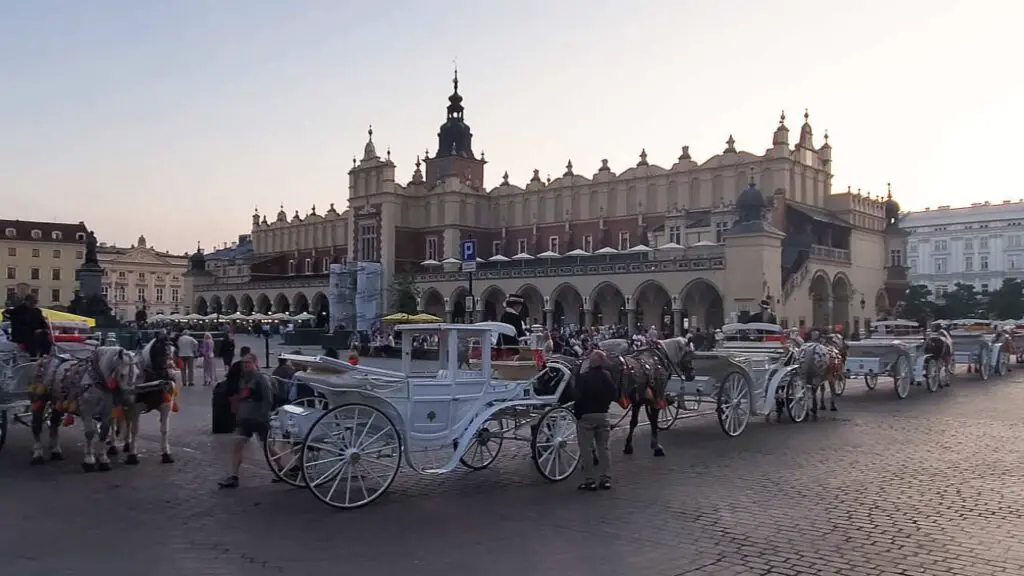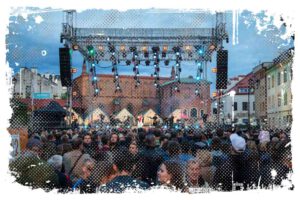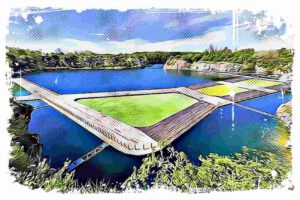Being in Kraków You can immerse yourself in music, art, architecture and history, all in one place. It all means nothing unless you learn something more about the city. That is why I present you the most interesting facts and information you should know about Krakow. So what makes this city truly unique? Lets find out.

Krakow is Poland’s Former Capital City
Here’s a fact for you: Krakow is one of the oldest cities in Poland, and it was the country’s capital. It boasts landmarks like the Wawel Castle and the Jagiellonian University, plus a bounty of monuments and artworks. I know, it’s a lot to take in. So, if you want to dig deeper into the heart of Krakow, here are some fascinating bits of trivia that’ll make your visit even more memorable:
1. Did you know Krakow was under Czech influence before Mieszko I’s reign?
Krakow used to be a fortress of the Vistulans tribe, known for their defensive prowess. This tribe fell under the Great Moravian State’s rule, likely during Świętopełk I’s reign. They were likely forced into baptism after their defeat. Although Krakow and Lesser Poland weren’t formally part of the Great Moravian Reich, it is believed that they paid tribute to it. Krakow’s official induction into Poland, as we know from Thietmar’s report, happened in 999.
↳ Make sure to read my guide to the most amazing places to stay in Kraków:
How to Find Best Place to Stay in Krakow Old Town – Your Guide
2. Krakow formally served as Poland’s capital from 1038 to 1795.
In 1596, King Sigismund III Vasa began relocating his royal court from Krakow to Warsaw, a process that wrapped up around 1611. Between 1596 and 1795, both Krakow and Warsaw shared the capital’s duties.
3. Krakow’s oldest road, the now-extinct Wysoka Droga, dates back to at least the 9th century.
This road played a crucial role in the trade route linking Ruthenia and Moravia, passing through Okół, which is considered Krakow’s first settlement.
4. Did you hear the St. Mary’s Basilica bugle call from the church’s north tower?
Every hour, the melody stops abruptly, symbolizing a trumpeter who was killed mid-tune by a Tatar arrow in 1241. However, I must tell you this story was crafted in the 1920s.
5. Krakow is home to about 780,000 people, a staggering 420% increase over the last century.
Prądnik Biały is the most densely populated district, housing over 72,000 inhabitants, while Łagiewniki and Borek Fałęcki are the least populated with around 16,000 residents.
6. The University of Krakow, established in 1364 by Casimir the Great, is still operating today.
Despite closing shortly after the king’s death, the university was revived 30 years later, on July 26, 1400, by Władysław Jagiełło. It’s been standing ever since.
7. Wawel, along with Old Town, Kazimierz, and Stradom, were declared UNESCO World Heritage Sites in 1978.
In 1994, the list expanded to include Podgórze, Nowy Świat, and Piaski. It’s worth to say that, in 2000, Krakow was named European Capital of Culture. So, when in Krakow, you are literally walking through history.
8. The largest museum in the city is The National Museum.
Back in 1879, the city council, with strong support from then-mayor Józef Dietl, decided to establish it. The museum’s very first artifact? The Torches of Nero painting, generously donated by the artist Henryk Siemiradzki himself. Now, its crown jewel is none other than Leonardo da Vinci’s 'Lady with an Ermine.’
9. Nearly 200,000 of Krakow’s residents are students.
They come from all over the globe to study at one of the city’s 24 universities. Talk about a multicultural melting pot!
10. In 2010, a unique attraction opened its doors – The Underground of the Main Market Square.
Imagine this, walking on glass footbrdges suspended above the ground, tracing the medieval city’s routes. All around you are centuries-old artifacts like coins, ornaments, and tools. The experience is amplified by a soundtrack, lighting effects, and interactive screens and projections. Quite the time travel, isn’t it?
11. During WWII, the Nazis looted countless works of art from Krakow.
But the city didn’t let that defeat it. Post-war, the locals set about reconstructing the damaged Wawel Castle and restoring its interiors to their Renaissance, Baroque and Classicist glory.
12. Krakow’s market is one of Europe’s largest.

The Main Square, established in 1257, spans two hundred meters on each side and is connected by eleven streets. Virtually every building around the square is a centuries-old architectural wonder.
13. As for size, the Main Square is the third largest in Poland.
Laid out on June 5, 1257, it measures 200 x 200 meters and initially belonged to King Bolesław the Chaste. It wasn’t until 1358 that Casimir the Great relinquished ownership rights. Today, it holds the title of the largest medieval market in Europe, only surpassed by the markets in Olecko and Latowicz, which were established later.
14. Here’s something you wouldn’t expect – A dachshund parade!
In Krakow, the „Dachshund March” is a regular event where dogs strut their stuff in costumes ranging from simple scarves to elaborate doctor, pilot, or knight outfits. Cute overload, right?
15. Krakow has had its share of natural disasters
Back in 1442 or 1443, a strong earthquake caused the vault of St. Mary’s Church to collapse.
16. The current St. Mary’s Square used to be a cemetery in the 18th century.
It was established in 1222 and lasted until 1796, when local sanitary regulations forced its closure.
17. Krakow’s first bishop, Poppon, was appointed in the year 1000.
He was German and held the office until 1008.
18. In 1993, the city played host to none other than Steven Spielberg.
He filmed scenes for his movie „Schindler’s List” in places like Schindler’s factory and St. Mary’s Church.
19. The legend of the knife hanging in the Cloth Hall.
The story goes that a man killed his brother with this knife when he saw that his brother’s tower was higher than his own. In reality, the knife served as a warning to thieves and a reminder of the harsh penalties for theft.
20. The Wawel Royal Castle, regarded by many as a magical place due to the legend of the chakra.
This sacred stone, hidden on Wawel Hill, is said to be a source of extraordinary energy. Some even believe it was thrown there by the Hindu god Shiva. Regardless of the truth, it adds to the captivating charm of Krakow.
21. Wawel Castle houses the Zygmunt Bell.
Commissioned by King Sigismund I the Old, this colossal bell weighs 11 tons. Its creation was completed in mid-1520 and it was installed on July 9, 1521. Imagine the sight: the king himself, his wife, and their court watching as the bell was hoisted to the tower, a process that took a whole hour. The bell first chimed in Krakow on July 13, forever marking the city’s soundscape. Crafted in 1520 by brothers Jan and Hieronim Köln of Nuremberg, this bronze bell stands an impresive 3.4 meters tall.
Famed artist Jan Matejko captured this historic event in a painting in 1874. The piece portrays the king with his entourage, and Stańczyk, the court jester, in the center. For many years, up until 1999, the Zygmunt Bell was the largest in Poland. It now holds the second spot, after the Mary Bogurodzica bell in Licheń.
Other Interesting Fact About Krakow’s History and Culture
As we continue this journey through Krakow, let’s delve into more interesting facets that make the city unique.
- In the 10th century, Krakow emerged as a vital commercial and cultural hub in Central Europe. It sat at the crossroads of trade routes connecting Scandinavia, Western Europe, Byzantium, and Slavic countries to the east. The city’s significance soared in the 11th century when it became the capital of Poland.
- The city of Krakow has a special place in the Catholic Church’s history. In 1978, its Archbishop, Karol Wojtyła, ascended to the papacy as Pope John Paul II, the first non-Italian pope since 455.
- Fancy a tour of the city? You can embark on a 3-hour electric car journey, exploring Krakow’s lesser-known cultural and artistic pockets.
- The Town Hall Tower in Krakow, situated on the Main Market Square, is an architectural marvel. At roughly 70 meters, its Gothic design dominates the surrounding buildings. Notable for its robust walls and decorative details, the tower is topped with a gallery of arcades, a clock, and a spire.
- Embracing the Old Town, the Vistula boulevard is the city’s favorite spot for relaxation. It offers sweeping views of the river, and a serene atmosphere that is best enjoyed on a leisurely walk.
- The Veit Stoss Altar in St. Mary’s Basilica is one of medieval Europe’s most important sculptural masterpieces. According to legend, Veit Stoss, the master sculptor, took 12 years to complete the altar, but the exact timeline remains unknown. The triptych altar, composed of oak wood, features over 200 intricate sculptures, and stands at an imposing height of 13 meters. Work on this artistic marvel began in 1477 and was completed in 1489.
- Krakow’s deep-rooted connection to the church is evident in the fact that it had its own bishop as early as the year 1000.
- The period from the 1470s to the 1480s is considered the „Golden Age of Krakow”. During this era, the city experienced significant growth in culture, art, and economy, making it a beacon of prosperity in Central Europe.
- In 2013, Krakow’s Main Market Square earned the title of „Best Market in the World” by the Lonely Planet, testament to its vibrant energy and cultural significance.
- Krakow’s origins are shrouded in legend. It is believed that the city was founded by Krakus, a mythical ruler who defeated a dragon dwelling on Wawel Hill. On the dragon’s defeat, Krakus established his abode on the hill and named the city in his honor.
- The Sukiennice, or the Cloth Hall, is a historic shopping hall situated in Krakow’s Main Market Square. This building is both an important monument and a popular tourist destination, known for its grandeur and historic significance.
- The Royal Castle on Wawel Hill has seen many fires throughout its existence. The most severe devastations took place in 1499, 1536, 1595, 1649, and 1702. Despite these ravages, the castle has managed to maintain its royal charm and stands today as a testament to Poland’s rich history.
- In some of Krakow’s museums or places of worship, photography may be restricted in order to protect art, privacy, or religious sensitivities. Before entering such places, it’s advisable to check whether there are any limitations on photography. Most popular attractions, like St. Mary’s Basilica, Wawel Castle, or the Cloth Hall, allow outdoor photography and are popular subjects for capturing the city’s beautiful vistas, architecture, and vibrant atmosphere.
- Krakow has earned the moniker „Rome of the North” owing to its wealth of temples. Sixty of these were built in the 20th century alone, further adding to the city’s religious and cultural richness.
- Among Krakow’s popular tales is the legend of the Wawel dragon. This formidable creature is said to have terrorized the city’s inhabitants, living on Wawel Hill. King Krak eventually sent the knight Krakus to defeat the dragon, who succeeded by tricking the beast into consuming a poison-laden piece of meat. Consumed by thirst due to the poison, the dragon drank from the Vistula river until it burst and died.
- Saint Faustina Kowalska, a significant figure in the Catholic faith, hails from Krakow. Her spiritual journey and messages of Divine Mercy continue to inspire millions of people around the world.
Notable Interments at Krakow’s Wawel Castle
Many Polish kings and other important historical figures are interred in the Wawel Cathedral. Here are some of the notable figures:
- King Władysław I Łokietek (1261-1333) – First king of Poland from the Piast dynasty.
- King Casimir III the Great (1310-1370) – He introduced numerous reforms in Poland and significantly expanded Wawel.
- King Władysław II Jagiełło (1362-1434) – Founder of the Jagiellonian dynasty who formed the Polish-Lithuanian union and led the victorious Battle of Grunwald.
- King Sigismund I the Old (1467-1548) – Longest reigning representative of the Jagiellonian dynasty who significantly contributed to the development of Poland.
- King Zygmunt II August (1520-1572) – Last king from the Jagiellonian dynasty and the final ruler to unify Poland and Lithuania.
- King Stefan Batory (1533-1586) – From the Batory dynasty, he introduced many reforms and had an effective foreign policy.
- King Jan III Sobieski (1629-1696) – Famous ruler who led the Polish army to victory over the Turks in the Battle of Vienna in 1683.
Polish queens, princes, archbishops, writers, scientists, and other figures who shaped Polish history are also laid to rest at Wawel, making it a place where history continues to be revered and remembered.
References:
- https://pl.wikipedia.org/wiki/Krak%C3%B3w




